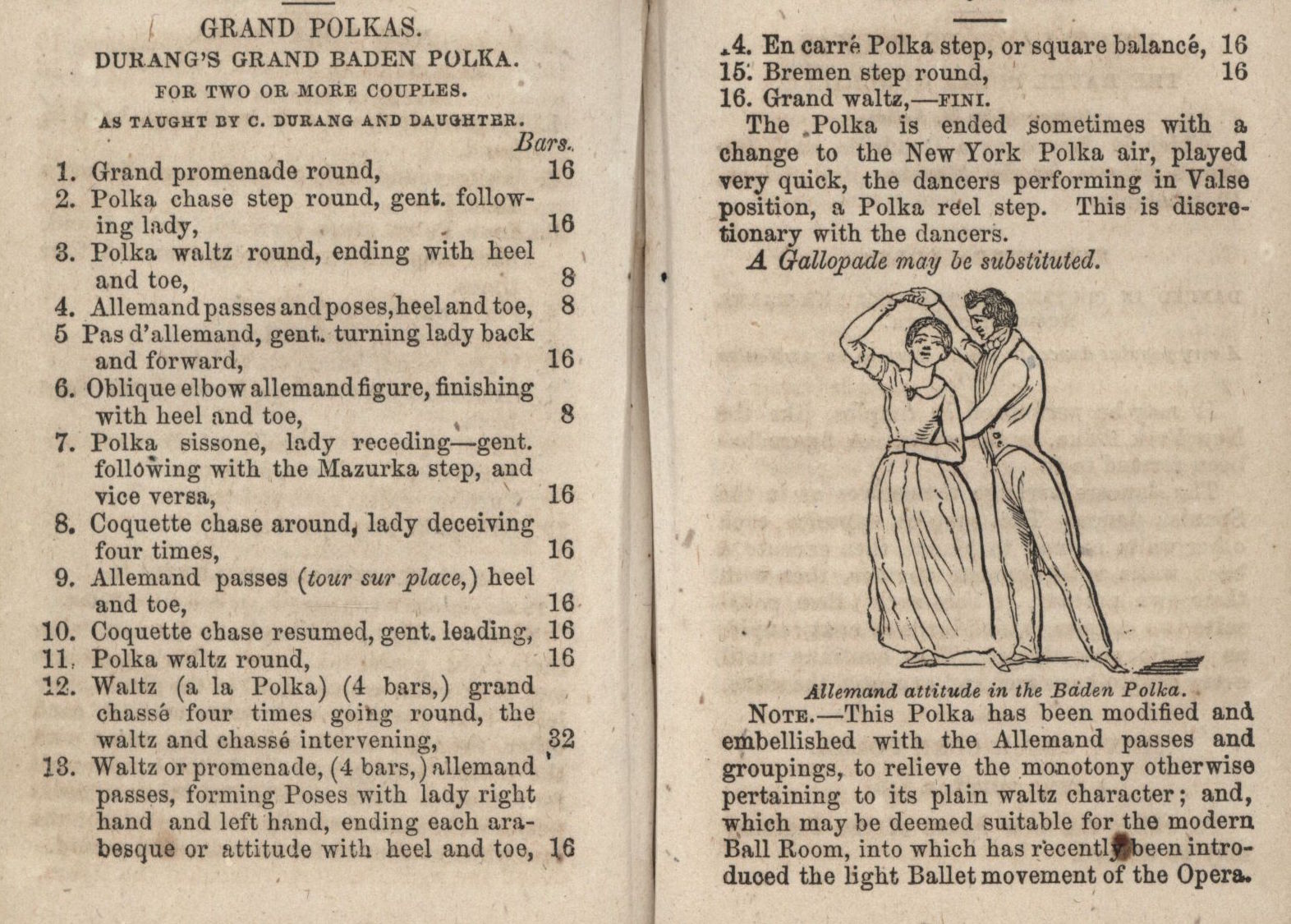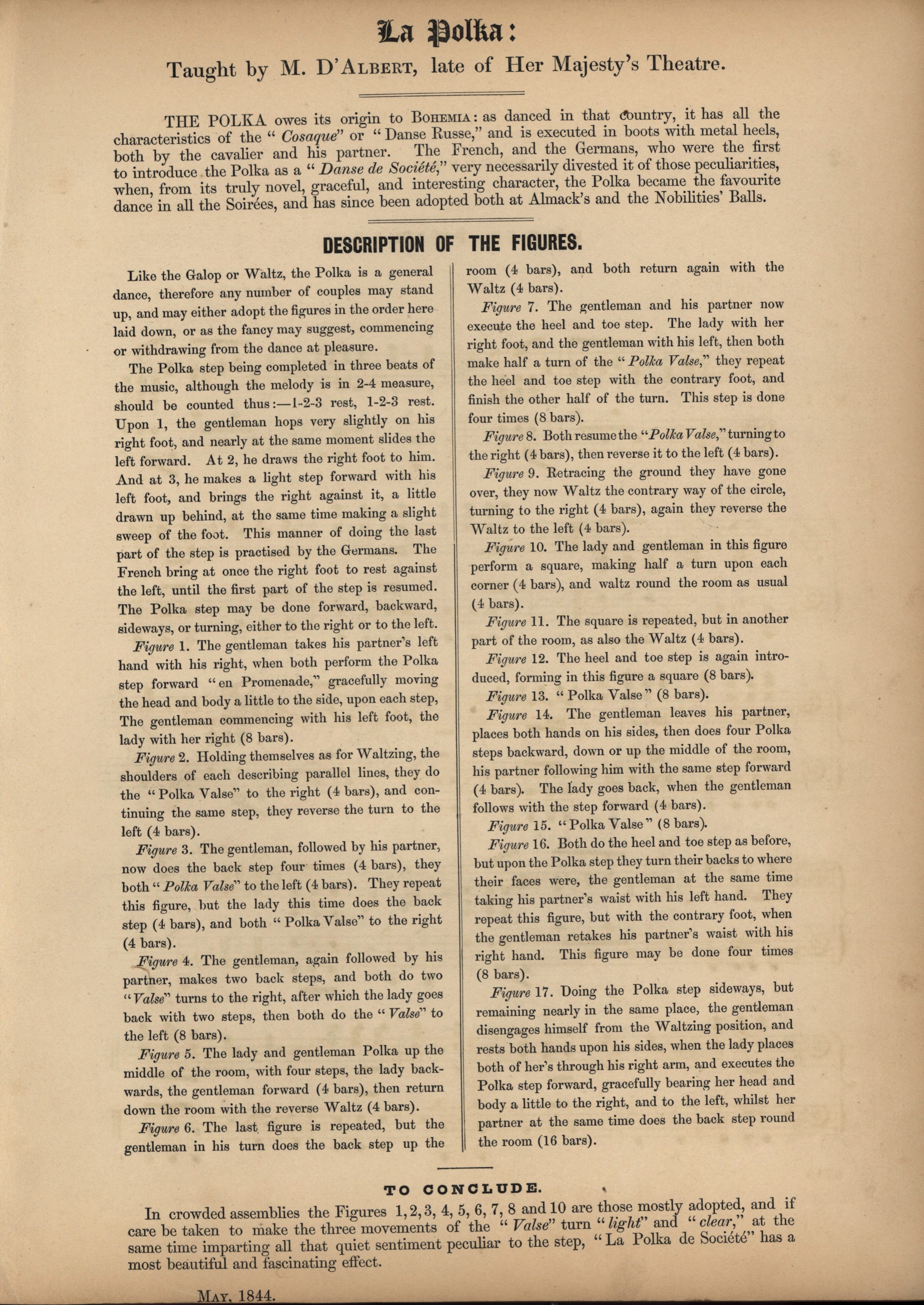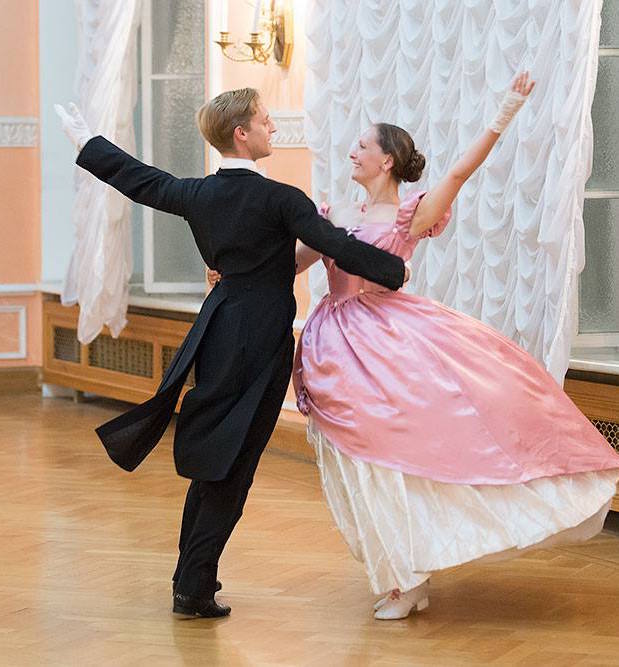Romany Polka
Описание танца на русском здесь
Long polka choreographies existed in the 19th century, choreographed for dance academy balls.
In the 1840s, Henri Cellarius, Charles D'Albert and Charles Durang were the three most famous
French / English / American dance masters. All three of them choreographed long polka sequences.

A polka sequence by Henri Cellarius, c.1845. It's 128 bars long, exactly the same length as my Bohemian
National Polka (Feuerfest Polka) choreography.

Charles Durang's Grand Baden Polka, one of three long polka sequences in Durang's Terpsichore, 1847.
Both this and his Monsieur Hazard's Polka are 240-bar choreographies, which are five minutes long.
A third example of a long polka choreography is shown on the next page. It's a 152-bar sequence by
Charles D'Albert, 1844. You will recognize all of the elements of the Romany Polka sequence (galops,
allemandes, stamps, heel and toe, moulinet, coup de talon, tour sur place) in these original examples.
Howe's Complete Ball-Room Hand-Book, 1858 Boston, contains two similar long polka choreographies.

Romany Polka
by Richard Powers
This polka is choreographed to the music Romany Life y Victor
Herbert, from his 19th century opera The Fortune Teller. The
choreography is named after the music, just as Durang's Grand
Baden Polka sequence was named after the tune Baden Polka.
The elements in this choreography are from 19th century dance
manual descriptions, from polka descriptions accompanying sheet
music, and some are from period illustrations (for instance, the
opening promenade position is from two illustrations of Jules
Perrot dancing a polka). These variations continued into the late
19th century, like the 120-bar New York Polka sequence in the
1882 Howe's New American Dancing Master. By the time Melvin
Ballou Gilbert wrote Round Dancing in 1890, he and other dance
masters had collected several decades of variations, keeping all
of them in their repertoire. So this polka sequence could have
happened anytime between 1844 and the 1890s.

Julien Tiberghien and Marie-émilie Capl
dancing Romany Polka in Moscow
Introduction
Phrase 1 Take partner's R hand in R hand.
Phrase 2 Honor partner.
Phrase 3 Lady turns CW under gent's R arm, then both face LOD on the final note.
meas
4 Walk LOD 8 slow steps in shoulder promenade position, gent beginning L, lady beginning R foot.
R hands are held extended forward; lady places her L hand on the gent's R shoulder.
1 Rock forward acknowledging partner and replace back. You may bob forward as in La Polkinade.
3 Cast away 6 walking steps to take open 2 hands.
4 Face-to-face polka, back-to-back swinging held hands forward, face-to-face, back-to-back.
2 Holding 2 open hands, do La Polkinade (by Henri Boizot, 1858): Gent glissé side L, chassé
(close) R to L, Jeté L LOD while lifting straightened rear leg RLOD, close R to L. Accent count 3.
Lady steps opposite.
2 Gent does a small L Pas de Basque in place then step R and lightly stamp L without weight, as
lady does a CW Allemande turn under the gent's L arm, with a two-step, then step L and close R.
Chorus
4 4 turning polka steps traveling LOD. 19th century style is to lean toward the direction of travel.
2 Heel & Toe toward LOD, then half-turn polka. (This is D'Albert's Figure 7 in the above example.)
2 Heel & Toe on opposite feet, toward LOD, then second half-turn of the polka.
Charles D'Albert's polka choreography said that dancers "may adopt the figures in the order here laid
down" or they may dance the figures "as the fancy may suggest." So continue with 4 polkas, or do this:
2 Optional variation: 2 turning polka steps, then releasing waltz position handhold.
2 Non-turning Polka step sideways toward LOD, releasing waltz position handhold. Gents half-turn
left (CCW) as ladies half turn right (CW) and do a back-to-back turning polka toward LOD.
2 La Polkinade, taking open 2-hand position. Or keep waltz position if you are doing 4 polkas.
2 Ladies CW Allemande underarm turn, as above. The gent lightly stamps L at the end, as the lady
closes R without weight (although some of the more spirited women would have stamped).
Part 1 Galop
2 Zig: Galop 4 slides diagonally LOD toward the center. (All three of Durang's polka sequences
included a gallopade.)
2 Zag: Turn halfway CCW and Galop 4 slides diagonally out beginning with opposite feet.
4 Polka in a Square. This is Charles D'Albert's Figure 10 from the above examples.
Polka step toward LOD (gent facing out) and quarter-turn CW*. Polka step "over the elbows"
toward the center and quarter-turn CW. Polka step RLOD and quarter-turn CW. Polka step
toward the outside and quarter-turn CW. Keep the original style of leaning toward the direction
of travel on each polka step.
Then to fit the accent of the music, replace the first polka step with a schottische step-hop,
leaning toward LOD. Charles Durang's "Butler Trot" style of polka (jeté polka) works best with
this variation. Clearly mark the timing of the fourth polka step, to accent the music.
* D'Albert wrote "half a turn" but he clearly meant a quarter-turn, to form a square pattern.
8 Repeat the Zig-Zag Galop and Polka in a Square.
Chorus As before. On the last measure ladies take 2 steps L-R instead of a step-close.
Ladies only half-turn under this time, to end facing RLOD.
Part 2 Separate from Partner, Tour sur Place
2 Beginning L foot, Galop Chassé 4 slides away from partner, gents separating toward the center,
ladies outward.
2 Double heel-toe R toward partner, folding arms crossed low in front.
2 Return to partner with 1 polka, R-L-R, and 2 walks, R-L.
4 Coup de Talon Tour sur Place: both partners place lowered extended R arms around partner's
waist and raise L arms, as shown in the photo on the previous page. 1) Click heels to the left,
2) step side L, 3) close R (or cross R slightly over L), in QQS timing, four times, turning in place.
4 Slip away to take R hands and Moulinet circle around partner CW 8 pas marché walking steps.
Try to walk faster (i.e. farther) with the walking steps than you did with the Coup de Talon steps.
Take waltz position on the last 2 walking steps for a polka, gaining your first foot free.
Chorus As before but faster. Note in Durang's Grand Baden Polka that the polka music
was "played very quick" at the end.
Coda
2 Galop 4 slides as a couple LOD.
2 Double Heel & Toe toward RLOD.
2 Galop 4 slides as a couple to RLOD. (D'Albert's Figure 9 also retraces a step in reverse LOD.)
2 Double Heel & Toe toward LOD.
4 4 turning polkas traveling LOD.
3 5 Pivots in place then Assemblé on ct. 6, keeping held hands, releasing and raising rear arms.
© 2016 Richard Powers
Performed by the Academy of Danse Libre, at the Stanford Fall Ball. The performance version of Romany Polka is slightly different from the social version

